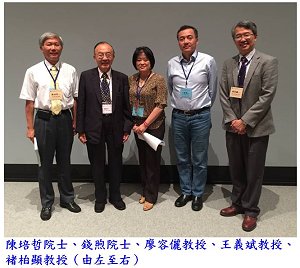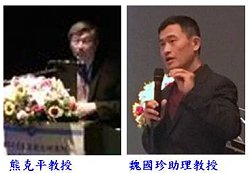NHRI Communications

會議報導
105年度國家衛生研究院生物醫學學術研討會紀實
Report on 2016 Biomedical Research Symposium of National Health Research Institutes
 105年度國家衛生研究院生物醫學學術研討會(2016 Biomedical Research Symposium of NHRI)已於8月15日至16日假本院會議中心舉行。今年度會議除依往例規劃2場大會特別演講(plenary lecture)及6項專題演講外,另外由中華民國心臟學會協辦規劃1場有關計畫書撰寫與執行之workshop註1(Title: From research proposal to peer-review),邀請錢煦院士、廖容儷教授、王義斌教授及陳培哲院士等4位專家分享其豐富的計畫申請、審查與執行經驗,以期提升計畫撰寫品質及成功執行研究計畫獲致具體成果。此次會議除有178位整合性醫藥衛生科技研究計畫(簡稱整合性計畫)研究人員參與外,亦邀請48位院外計畫學術審查之國內、外專家共同與會,另開放本院研究人員及國內各機構研究人員186位報名與會,總計人數超過400人次,可謂盛況空前,充分達到學術交流之目的。
105年度國家衛生研究院生物醫學學術研討會(2016 Biomedical Research Symposium of NHRI)已於8月15日至16日假本院會議中心舉行。今年度會議除依往例規劃2場大會特別演講(plenary lecture)及6項專題演講外,另外由中華民國心臟學會協辦規劃1場有關計畫書撰寫與執行之workshop註1(Title: From research proposal to peer-review),邀請錢煦院士、廖容儷教授、王義斌教授及陳培哲院士等4位專家分享其豐富的計畫申請、審查與執行經驗,以期提升計畫撰寫品質及成功執行研究計畫獲致具體成果。此次會議除有178位整合性醫藥衛生科技研究計畫(簡稱整合性計畫)研究人員參與外,亦邀請48位院外計畫學術審查之國內、外專家共同與會,另開放本院研究人員及國內各機構研究人員186位報名與會,總計人數超過400人次,可謂盛況空前,充分達到學術交流之目的。 本次會議邀請南加州大學醫學工程學系熊克平教授及長庚大學醫學院醫學系魏國珍助理教授擔任大會特別演講講員。會議首日上午由本院余幸司代理院長主持開幕,隨後由熊克平教授以「Ultrasound: Past, present and future註2」為題發表演說;次日上午則由魏國珍助理教授以「Preclinical studies of FUS-induced BBB opening for brain tumor treatment註3」為題發表演說。
本次會議邀請南加州大學醫學工程學系熊克平教授及長庚大學醫學院醫學系魏國珍助理教授擔任大會特別演講講員。會議首日上午由本院余幸司代理院長主持開幕,隨後由熊克平教授以「Ultrasound: Past, present and future註2」為題發表演說;次日上午則由魏國珍助理教授以「Preclinical studies of FUS-induced BBB opening for brain tumor treatment註3」為題發表演說。除前述plenary lecture外,另規劃Cancer Research、Medical Engineering、Molecular Genetics and Medicine、Neural Science、Biomedical Science及Population Health Research等6項專題演講,由參與院外計畫學術審查之國內、外專家、執行成果優良之整合性計畫主持人、本院研究人員或年輕研究學者及國內專家共24位,於2個會場同步進行,分享其研究成果與經驗,促進學術交流及研究合作。
囿於演講場次有限,本次會議另安排兩個壁報時段(poster session),由整合性計畫主持人及本院研究人員張貼壁報展示研究成果(共計發表113篇壁報論文),並分組安排壁報論文討論會議(poster discussion),由各組會議主持人邀請部分壁報展示之研究人員簡短報告分享研究成果,以促進壁報發表者、計畫主持人、所有分組與會人員及學術審查委員間之討論與互動,除有助於委員瞭解計畫執行成效,亦能協助解決研究過程可能遭遇之困難。
在2天的學術活動中,藉由演講、壁報論文展示及分組討論會議等安排,引發熱烈討論及腦力激盪,使與會人員獲益良多,且因交流互動增加,也促進未來合作或團隊研究形成之可能,為國人之醫藥研究發展水準厚植潛力。

註1:Workshop (Title: From research proposal to peer-review)
(各講員演講內容請見國衛院電子報第668期「影音節目」)
講員1:錢煦院士演講摘要
Title: How to maximize the chance of success in writing a research proposal?
1. NHRI innovative research grant application review criteria
2. Review criteria used by NIH in USA
3. Some elements in choosing innovative and important problems
4. Scientific ethics: Avoidance of scientific misconduct
講員2:廖容儷教授演講摘要
Title: Path towards a successful research proposal
The purpose of this lecture is to help early career stage investigators learning how to conceptualize their scientific ideas, communicate their findings, and prepare a successful research proposal. First and foremost, a strong proposal is built upon innovative and impactful scientific ideas and solid scientific facts. Once the scientific concept has been hypothesized, equally important is how to articulate such scientific idea through clear communication on paper. There is no fixed formula for writing a proposal. However, the task is to convince the scientific review committee that you have identified a critical scientific problem or novel discovery and you have methodical approaches to resolve such problem. Most importantly, results obtained from the proposal will move the field forward in a scientifically significant manner and/or contribute to disease mechanisms and cures.
講員3:王義斌教授演講摘要
Title: Demystify peer-review process in science
Peer-review process is an essential part of scientific enterprise, embedded in every fabric of scientific discovery, knowledge dissemination and technological progress. For academic careers, peer-review process is viewed by many as either a path towards or a barrier to their successes. Especially among junior investigators, peer-review process seems to be very mysterious and remote, and sending your papers or grant proposals for review is like to go for a “blind date”, both exciting and fearful, hoping for best and dreading for the worst. It is not a matter of whether you will encounter failures or setbacks in this process, we all do! However, how to prepare for the best and how to deal with the negative outcome will have a major impact on your long-term success. In 2014, I was commissioned by American Heart Association to discuss this issue among junior investigators in the cardiovascular field. In preparation for that task, I interviewed editors of several leading journals as well as administrative leaders of major funding agencies. I learnt a great deal of the peer-review process from both sides. As scientists and members of our scientific communities, many of us will play different roles in the peer-review process, as an author or applicant, or a reviewer. In this session, I will share the insights I have learnt from these discussions and from my own experiences, and attempt to shed some light to the seemingly mysterious process of peer-review.
講員4:陳培哲院士演講摘要
Title: How to conduct clinical research?
The clinical research is an essential process to translate basic researches into clinical applications or to define the unmet needs for future studies. The goals are to change the clinical practice and to benefit the health of human beings. What are the differences and the similarities between the clinical versus basic research? At the beginning, both are the same because all adopt scientific methodology: starting from a hypothesis, designing a protocol, then carrying out the studies prospectively, and finally analyzing the results carefully. One first step to remind is to introduce the scientific methodology into clinical research. The main difference between the clinical and basic research are the study subjects. Most clinical studies involve the humans or human samples as the subjects. Therefore, the PI has to pay extensive attention to care the right/privacy or the study subjects. Ethical and legal consideration comes first and dominates over scientific consideration. The point has to be emphasized again and again. The second difference is the requirement of participating staff. Many of clinical studies or trials can only be conducted by professional staff with certificates. This is necessary to maintain the study quality and to do no harm on the subjects. The third, the clinical study has better to be monitored or interpreted by an independent committee or auditing team, to minimize bias and to keep objectivity. Finally, the disclosure of conflict interest has to be implemented systemically. In conclusion, the key element for a successful clinical research is a well-educated and rule-abiding PI and a closely-watched system to ensure appropriate process, or conduct.
註2:熊克平教授特別演講摘要(演講內容請見國衛院電子報第665期「影音節目」)
Title: Ultrasound: Past, present and future
Diagnostic ultrasound has become an important tool in medicine since its inception in early 1950s. It possesses several advantages over other medical imaging modalities, namely, non-invasiveness, real-time capability and portability. Current state-of-the art ultrasound scanners are capable of real-time B-mode imaging, color Doppler blood flow mapping, 3D imaging and elastography which will be reviewed in this talk along with developments in contrast agents, high frequency ultrasound and miniaturization which may be the future of ultrasound.
Therapeutic ultrasound, although started at the same time as diagnostic ultrasound, has not received much attention until recently. Drug delivery through the blood brain barrier in the brain and high intensity focused ultrasound (HIFU) for treating brain disorders and other medical problems have raised intense interest. This topic and current state of medical ultrasound industry in Taiwan will be discussed as well.
註3:魏國珍助理教授特別演講摘要(演講內容請見國衛院電子報第666期「影音節目」)
Title: Preclinical studies of FUS-induced BBB opening for brain tumor treatments
Malignant glioma is a severe primary CNS cancer with a high recurrence and mortality rate. The current strategy of surgical debulking combined with radiation therapy or chemotherapy does not provide good prognosis, tumor progression control, or improved patient survival. The blood-brain barrier (BBB) acts as a major obstacle to chemotherapeutic treatment of brain tumors by severely restricting drug delivery into the brain. Because of their high toxicity, chemotherapeutic drugs cannot be administered at sufficient concentrations by conventional delivery methods to significantly improve long-term survival of patients with brain tumors. Temporal disruption of the BBB by microbubble-enhanced focused ultrasound (FUS) exposure can increase CNS-blood permeability, providing a promising new direction to increase the concentration of therapeutic agents in the brain tumor and improve disease control. Under the guidance and monitoring of MR imaging, a brain drug-delivery platform can be developed to control and monitor therapeutic agent distribution and kinetics. The success of FUS BBB disruption in delivering a variety of therapeutic molecules into brain tumors has recently been demonstrated in an animal model. In this paper the authors review a number of critical studies that have demonstrated successful outcomes, including enhancement of the delivery of traditional clinically used chemotherapeutic agents or application of novel nanocarrier designs for actively transporting drugs or extending drug half-lives to significantly improve treatment efficacy in preclinical animal models.
《文/圖:學術發展處》